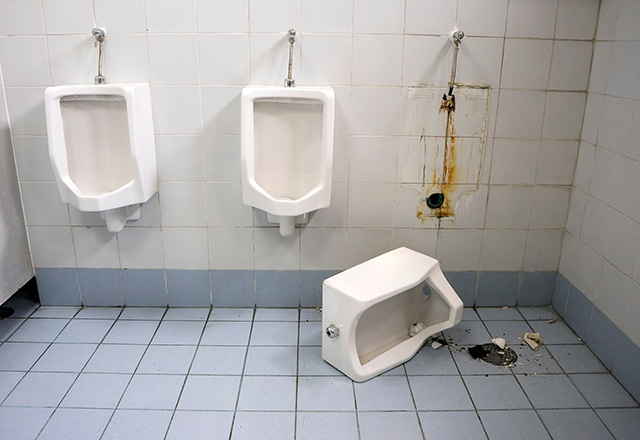Tips for Handling Restroom Vandalism
There may not be a good answer as to why restrooms are vandalized, but there are products and methods available to help with discouraging the act.
- By Klaus Reichardt
- 03/27/20
In February 2019, the high-school newspaper of a Wisconsin school had the following headline: "Vandals Overrun the Bathrooms." The story details how vandalism in the bathrooms — more specifically, the boys’ bathrooms — is a growing concern. According to the article, toilets are filled to the brim with paper products, soap dispensers are broken and urinal flush valves are tampered with. Further, garbage cans are flipped upside down, some doors are off their hinges and garbage is "flooding the floors."
One boys’ bathroom is now closed indefinitely, according to the paper, with no estimate as to when it will be reopened. The school has notified students and parents that they only have "so much money" to spend on repairs and they don't want to ask teachers and staff to give up their free time to supervise bathrooms. As to who the culprits are, the article does not provide names or answers. What it does say is that "the school knows these events are on the rise during lunch and after school."
This same situation is occurring in schools throughout the country in varying degrees. It’s degrading to teachers, students and their parents. It makes schools unsafe, negatively impacts morale and, unfortunately, vandalism tends to breed more vandalism, making this an ongoing problem.
There may be several reasons why boys vandalize restrooms. Some studies say it is caused by school bullies, while other studies say it is the boys that are bullied that are the ones causing vandalism. Possibly it’s anger release either way. Maybe it's just part of growing up.
We will let the experts figure it out, and possibly provide some answers as to how to stop it. In the meantime, our focus here is on how to deal with it. The following are some suggestions for school administrators.
Act Fast
We already referenced this earlier. Police often advise building owners that have property vandalized to clean things up, repaint if necessary, as quickly as possible. They know vandalism invites more vandalism. The same is true in schools. If funds are not available to do this, then a regrettable option is the one mentioned above: close the bathroom until repairs can be made.
Redesign Bathroom Entrances
All types of facilities have found that when they remove doors and replace them with labyrinth entrances to bathrooms, vandalism goes down. Vandals like to work secretly and in private. Labyrinth entrances remove this level of secrecy. Also, vandals can be caught "red-handed." If the bathroom has a door, they will hear the door open and stop. But with no door, they never know if someone walks in unexpectedly.
Toilet Vandalism
Many experts now suggest installing stainless-steel toilets. Ceramic toilets can be damaged and cracked and, when this happens, they likely will need to be replaced. Further, once cracked, it is easier to remove mechanical parts inside the toilet. It is much harder to damage a stainless-steel toilet, and these tend to be much more challenging to break into. Further, do not install manual flush handles. These are often abused. Sensor-controlled flushing systems, preferably built into the wall, are less likely to be damaged.

Photo by Surchesth
Urinals
With urinals, it is not the ceramic body of the urinal that gets the attention of vandals, but the flush handles, just like toilets. This applies to both manual and sensor-controlled flush handles because both are installed directly above the urinal. As with toilets, sensors should be installed in a wall. However, a less expensive option is to install no-water or waterless urinals. These urinals have no flush handles and, because they do not use water, school administrators need not be concerned with another chronic problem: clogged-up urinals.
Paper Products
This can be a complicated issue to address. However, we know paper products in rolls are easier to tamper with. School administrators should consider single-sheet paper towels and toilet paper. They take more time to meddle with. Whichever type is selected, the dispensers should be securely attached to walls and partitions and have an advanced — key needed — locking mechanism.
Other Concerns
We have not addressed graffiti yet, but as we know, that can be a widespread problem. When selecting paint for school bathrooms, the color should be less an issue than if the paint is graffiti resistant. These paints make it easier to clean and remove the graffiti.
Some restrooms — as well as most janitorial closets — will have wall faucets for water. Secure these with faucet locks. There are even vandal-resistant aerators. Installing aerators on bathroom sinks is one of the least expensive ways to reduce water consumption. However, most can be removed in seconds. These vandal-resistant aerators help prevent this.
Upgrade Budgets
The final advice is for school districts to have “upgrade budgets." Very often when bathrooms are damaged, paying for repairs comes under operating budgets. However, an upgrade budget allocates funds just to install vandalism-resistant restroom fixtures and paints. Invariably, this will be cost savings. The more money invested in vandal-resistant upgrades, the less money will be needed for repairs.
About the Author
A frequent speaker and author on water conservation issues, Klaus Reichardt is founder and CEO of Waterless Co. Inc.(www.waterless.com), based in Vista, CA. Reichardt founded the company in 1991 with the goal to establish a new market segment in the plumbing fixture industry with water efficiency in mind. The company manufactures restroom and plumbing-related products.